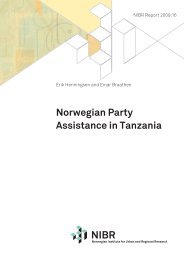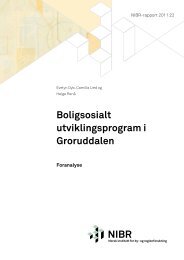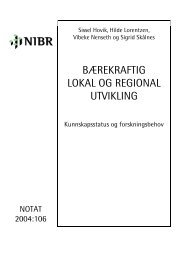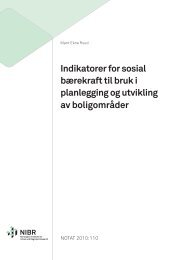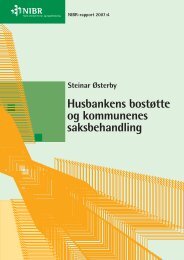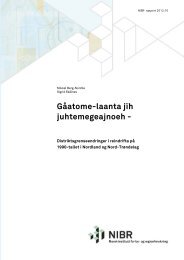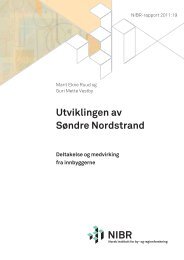http://www.tandfonline.com/page/terms-andconditions
The special importance of housing policy for ethnic minorities ...
The special importance of housing policy for ethnic minorities ...
- No tags were found...
Create successful ePaper yourself
Turn your PDF publications into a flip-book with our unique Google optimized e-Paper software.
International Journal of Housing Policy 17Downloaded by [Norsk Institutt for By og] at 07:07 11 March 2013is no systematic connection between in<strong>com</strong>e inequality and ethnic inequality in housingout<strong>com</strong>es.The Norwegian housing market has higher in<strong>com</strong>e segmentation than the other countries.Thus, in the case of Norway the low tenure segmentation of immigrants cannot beexplained by low-in<strong>com</strong>e segmentation. When <strong>com</strong>paring Denmark with Sweden and Finland,the higher tenure segmentation of immigrants can be associated with higher in<strong>com</strong>esegmentation. Differences in in<strong>com</strong>e segmentation can thus to some extent explain whyimmigrants are more unequally distributed among tenures in Denmark than in Sweden. Butit cannot explain why the ethnic segmentation is higher on the Finnish market and loweron the Norwegian. In the Finnish case, one explanation could be that immigrants are to agreater extent new<strong>com</strong>ers and that larger proportions of Danish, Swedish and Norwegianimmigrants have had longer time to ‘climb up the housing ladder’.It is also difficult to explain the differences between the various countries concerningimmigrants in overcrowded housing as caused only by variation across the countriesconcerning differences between in<strong>com</strong>e groups. The high degree of overcrowding amongimmigrants in Norway can thus not be explained by differences between in<strong>com</strong>e groups,which are in fact smaller than in the other countries. The differences between the othercountries cannot be accounted for by in<strong>com</strong>e differences. Some of the differences musttherefore be explained by particular features in the housing systems.The central research question examined in this article is whether a <strong>com</strong>parison ofimmigrants’ housing situation and of housing policies in four Nordic countries makes itpossible to identify specific elements of national housing policies that have had a specialsignificance for the housing out<strong>com</strong>es of immigrants.Our <strong>com</strong>parison of countries reveals that ethnic tenure segmentation, which often resultsin spatial segregation of immigrants, is only to some extent a consequence of in<strong>com</strong>esegmentation of housing markets. This indicates that differences in housing policies canhave special consequences for immigrants additional to the effect on in<strong>com</strong>e groups.The Norwegian case shows that a lack of sufficient rental housing in a country can pushimmigrants into owner-occupation, which could be seen as desirable. But the price for thispolicy has been that many immigrants live in overcrowded ac<strong>com</strong>modation. Moreover, thelack of rental housing results in a high demand pressure on rental housing. This makesroom for increased rents but also discrimination, which has been well documented in theNorwegian case (Røed Larsen & Sommervoll, 2011; Søholt & Astrup, 2009a).In the other three countries, there is more rental housing and social/public housing,especially in Denmark. But these sectors have been organised differently. Important differencesfor immigrants are rent and price controls in private renting and cooperatives, thesize of the social/public housing sector, and rules of access to social/public housing.The Danish case shows that immigrants’ housing options and experience of discriminationare strongly influenced by regulation of the private rental market and a lack oftransparency in housing transactions. Strong rent control, as in Denmark, is damaging thehousing possibilities of immigrants in private renting because rents below the market levelcreate queues, which give landlords options to choose between house hunters. They tend tochoose family and acquaintances as tenants, and, as immigrants seldom have good informalcontacts with landlords, they experience difficulties in gaining access to these dwellings.Moreover, the room for direct discrimination increases, which has to some extent beendocumented in Denmark. Also, price control in cooperatives in Denmark has resulted in astrong under-representation of immigrants in this tenure because of stronger <strong>com</strong>petitionbetween house hunters, which immigrants tend to lose in absence of personal contacts tomembers of the co-operatives.



